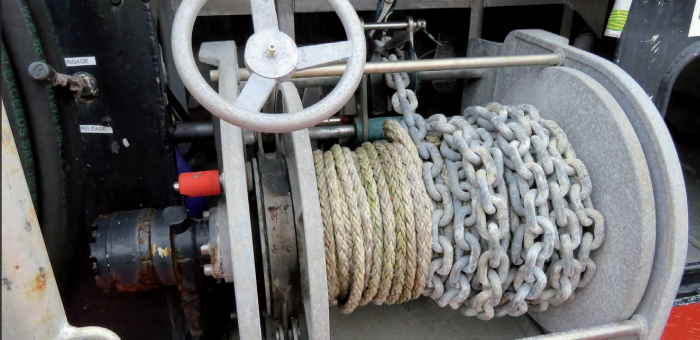UK MAIB in its latest Safety Digest presents a case where a windfarm support vessel was trying to anchor when the low fuel pressure alarm on the starboard engine sounded. When a crewman released the windlass the anchor failed to ‘free fall’. As the vessel was in danger, the master called the coastguard, a lifeboat was deployed and the vessel was towed safely.
The incident
A 21m aluminium windfarm support vessel was on an overnight coastal passage, returning to its home port when it lost propulsion. Attempts by its two-man crew to anchor the vessel were unsuccessful and shore assistance was required to prevent it being set onto the shore.
[smlsubform prepend=”GET THE SAFETY4SEA IN YOUR INBOX!” showname=false emailtxt=”” emailholder=”Enter your email address” showsubmit=true submittxt=”Submit” jsthanks=false thankyou=”Thank you for subscribing to our mailing list”]
In the morning, the vessel’s port engine shut down without warning and, despite attempts by the crew, could not be re-started. The master alerted the coastguard of the situation and advised that he intended to continue on passage using the starboard engine.
A little later, the low fuel pressure alarm on the starboard engine sounded. The master ordered his crewman to prepare the anchor for letting go. As the crewman arrived on the forecastle, the engine stopped and the order was given to let go the anchor. However, when the crewman released the windlass the anchor failed to ‘free fall’.
After seeing this, the master went aft and deployed the emergency anchor over the stern of the vessel. After a sufficient amount of anchor rope had been payed out the master secured it to one of the vessel’s Samson posts. As the weight of the vessel came onto the emergency anchor line the multi-plait rope parted.
As the vessel was close to danger, the master made a “Mayday” call to the coastguard, a lifeboat was deployed and the vessel was towed safely into harbour without further incident.
Probable cause
The port engine failed because of an electronic fault caused by water ingress, through a leaking hatch cover, into the diesel engine’s electronic control panel.
The starboard engine failed because of blocked fuel filters. Both issues were cause by inadequate maintenance and operational routines. The hatch cover had not been properly sealed and the condition of the fuel in the vessel’s tanks had not been monitored during the vessel’s lay-up period.
- It is important to ensure that the seals on all watertight openings are maintained in good condition and that weather deck openings are kept closed during sea passages. Similarly, the condition of the fuels contained in storage tanks should be closely monitored and tank drains should be regularly checked for the presence of water or sludge.
- One of the most significant safety issues identified in this incident was the crew’s inability to anchor the vessel in an emergency. The post-incident inspection by the anchor windlass manufacturer revealed that the aluminium windlass bearings were clogged with dirt and, although it could still be operated under power, the debris prevented the anchor being ‘let go’ in the ‘free fall’ mode. A subsequent fleet-wide inspection revealed a similar defect in other vessels. This issue had not been previously exposed by either class or regulatory inspection. Following its investigations, the vessel operator introduced a planned maintenance routine that required weekly fresh water wash down of the windlass, anchor ‘free fall’ mode tests and an annual overhaul.
- There was no documentation for the vessel’s emergency anchor line and the residual strength of the multi-plait rope was not tested during the vessel owner’s investigation. However, it was clearly apparent that the rope was not strong enough for the job. Following its investigation, the vessel operator sourced a new emergency anchor rope with a certified strength that was able to not only secure the vessel in an emergency, but also to do so without exceeding the safe working load of the vessel’s Samson posts.






























































